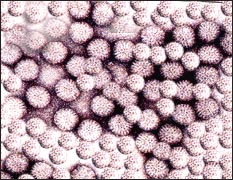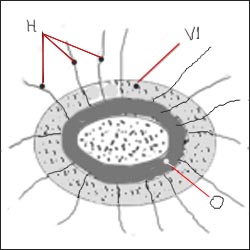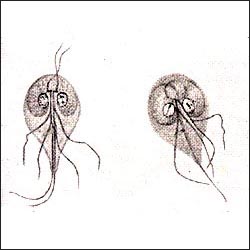바이러스 위장염, 박테리아 위장염, 또는 기생충 위장염으로 생기는 감염성 설사 Diarrhea due to viral, bacterial or parasitic gastroenteritis

사진 71. 전자 현미경으로 본 로타바이러스의 사진.
Copyright ⓒ 2011 John Sangwon Lee, MD., FAAP

그림 72. 보통 현미경으로 본 구균 박테리아의 그림.
Copyright ⓒ 2011 John Sangwon Lee, MD., FAAP

그림 73. 살모넬라 타이피균의 그림
H- H 항원, V1-V1 항원, O-O항원
참조문헌-Review of medical microbiology. 9th ed. Ernest Jawetz and etc

그림 74. 현미경으로 본 람불편모충
Copyright ⓒ 2011 John Sangwon Lee, MD., FAAP
원인과 개요
- 로타바이러스,
- 에코바이러스,
- 엔테로바이러스,
- 폴리오바이러스,
- 콕사키바이러스,
- 장 아데노바이스,
- 애스트로바이러스,
- 케리바이러스,
- 코로나바이러스,
- 토로바이러스,
- 노로바이러스(Noroviruses), 또는 그외 다른 여러 종류의 바이러스들 중 한 종류의 바이러스가 호흡기에 감염되면 바이러스 호흡기 감염병이 생기고 소화기계통에 감염되면 바이러스 소화기 감염병이 생기고 소화기 바이러스 감염병으로 구토, 복통, 설사의 증상 징후가 생기는 것이 보통이다.
- 살모넬라균,
- 콜레라균,
- 예르시니아균,
- 캄필로박터,
- 이질균(시겔라),
- 병원성 대장균,
- 에르시니아균,
- 리스테리아, 사
- 이클로스포라 등 부미원포자충, 또는 크립토스포리디움과 포자충 등의 박테리아 위장염이나 포자충 위장염 등으로 생긴 위장염으로 설사를 할 수 있다.
- 그 외 클로스트리듐 디피실레(Clostridium difficile 참조),
- B. cereus,
- 캄필로박터,
- 포도상구균 등의 박테리아 감염으로 위장염이 생길 수 있고 그로 인해서도 설사를 할 수 있다.
- 여러 종류의 박테리아나 바이러스 중 살모넬라세균 감염과 로타바이러스 감염으로 생긴 위장염이 소아들에게 잘 생길 수 있고 그로 인해 설사와 구토를 할 수 있다.
- 이렇게 박테리아나 바이러스 또는 포자충 등 병원체 감염에 의해서 생기는 설사를 감염성 설사(전염성 설사/ Infectious diarrhea)라 한다.
- 감염성 설사가 급성으로 생길 때는 급성 감염병 설사라고 한다.
- 더 자세한 설명은 각 질병 편을 참고한다.

사진 75.병원체가 항문→손→입→변→등의 경로로 감염되어 감염성 위장염이 생길 수 있다.
그로 인해 설사를 할 수 있다.
대부분의 감염성 위장염은 손을 깨끗이 씻고 위생 관리를 잘 하고 음식물을 챙겨 먹으면 예방될 수 있다. Copyright ⓒ 2011 John Sangwon Lee, MD, FAAP
Diarrhea due to viral, bacterial or parasitic gastroenteritis 바이러스 위장염, 박테리아 위장염, 또는 기생충 위장염으로 생기는 감염성 설사

Picture 71. Picture of rotavirus seen under an electron microscope. Copyright ⓒ 2011 John Sangwon Lee, MD., FAAP

Figure 72. Illustration of aureus bacteria seen under a normal microscope. Copyright ⓒ 2011 John Sangwon Lee, MD., FAAP

Figure 73. Illustration of Salmonella typhi H-H antigen, V1-V1 antigen, O-O antigen References-Review of medical microbiology. 9th ed. Ernest Jawetz and etc

Fig. 74. Lambite caterpillar seen under a microscope Copyright ⓒ 2011 John Sangwon Lee, MD., FAAP
Cause and overview
• rotavirus,
• Ecovirus,
• Enterovirus,
• poliovirus,
• Coxsackie virus,
• Intestinal Adenoweiss,
• astrovirus,
• Kerry virus,
• Coronavirus,
• Torovirus,
• Noroviruses, or one type of virus from many other types of viruses, infects the respiratory tract, causing viral respiratory infections. Infecting the digestive system results in viral digestive tract infections. Symptoms usually develop.
• Salmonella,
• cholera bacteria,
• Yersinia,
• Campylobacter,
• Shigella (Shigella),
• pathogenic E. coli,
• Ersinia,
• Listeria, Inc.
• Diarrhea may be caused by gastroenteritis caused by bacterial gastroenteritis such as Eclospora or spore spores, or bacterial gastroenteritis such as Cryptosporidium and spores. • Other Clostridium difficile (see also Clostridium difficile),
• B. cereus,
• Campylobacter,
• Bacterial infections such as staphylococcus can lead to gastroenteritis, which can also lead to diarrhea.
• Among many types of bacteria or viruses, gastroenteritis caused by Salmonella infection and rotavirus infection can occur in children, which can lead to diarrhea and vomiting.
• Diarrhea caused by infection with pathogens such as bacteria, viruses, or spores is called infectious diarrhea (infectious diarrhea).
• When infectious diarrhea occurs acutely, it is called acute infectious diarrhea.
• For more detailed explanation, refer to each disease section.

Picture 75: Infectious gastroenteritis can occur due to infection of the pathogen through the anus → hand → mouth → stool → back. This can lead to diarrhea. Most infectious gastroenteritis can be prevented by washing your hands thoroughly, keeping good hygiene, and eating with food. Copyright ⓒ 2011 John Sangwon Lee, MD, FAAP
출처 및 참조 문헌 Sources and references
- NelsonTextbook of Pediatrics 22ND Ed
- The Harriet Lane Handbook 22ND Ed
- Growth and development of the children
- Red Book 32nd Ed 2021-2024
- Neonatal Resuscitation, American Academy Pediatrics
- www.drleepediatrics.com제7권 소아청소년 감염병
- www.drleepediatrics.com제9권 소아청소년 소화기 질환
- Red book 29th-31st edition 2021
- Nelson Text Book of Pediatrics 19th — 21st Edition
- The Johns Hopkins Hospital, The Harriet Lane Handbook, 22nd edition
-
Childhood Emergencies in the Office, Hospital and Community, American Academy of Pediatrics
-
Emergency Medical Service for Children, By Ross Lab. May 1989. p.10
-
Emergency care, Harvey grant, and Robert Murray
-
Emergency Care Transportation of Sick and Injured American Academy of Orthopaedic Surgeons
-
Emergency Pediatrics A Guide to Ambulatory Care, Roger M. Barkin, Peter Rosen
-
Immediate care of the acutely ill and injured, Hugh E. Stephenson, Jr
-
The Critically Ill Child, Diagnosis and Management, Edited by Clement A. Smith
-
Emergency Medical Services for Children: The Role of the Primary Care Provider, America Academy of Pediatrics
-
Quick Reference To Pediatric Emergencies, Delmer J. Pascoe, M.D., Moses Grossman, M.D. with 26 contributors
-
Manual of Emergency Care
-
응급환자관리 정담미디어
-
소아가정간호백과–부모도 반의사가 되어야 한다, 이상원
-
Neonatal Resuscitation American heart Association
-
Neonatology Jeffrey J.Pomerance, C. Joan Richardson
-
Pediatric Resuscitation Pediatric Clinics of North America, Stephen M. Schexnayder, M.D.
-
Pediatric Critical Care, Pediatric Clinics of North America, James P. Orlowski, M.D.
-
Preparation for Birth. Beverly Savage and Dianna Smith
- Infectious disease of children, Saul Krugman, Samuel L Katz, Ann A. Gershon, Catherine Wilfert
-
The Harriet Lane Handbook 19th Edition
-
소아과학 대한교과서
-
제1권 소아청소년 응급의료 참조문헌과 출처
-
Other
Copyright ⓒ 2015 John Sangwon Lee, MD., FAAP
“부모도 반의사가 되어야 한다”-내용은 여러분들의 의사로부터 얻은 정보와 진료를 대신할 수 없습니다.
“The information contained in this publication should not be used as a substitute for the medical care and advice of your doctor. There may be variations in treatment that your doctor may recommend based on individual facts and circumstances. “Parental education is the best medicine.”